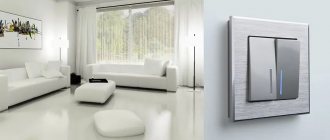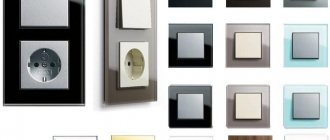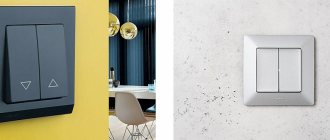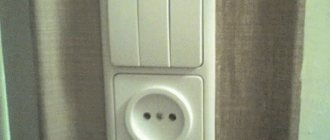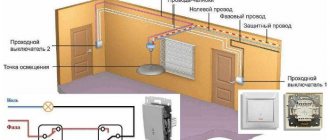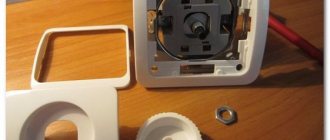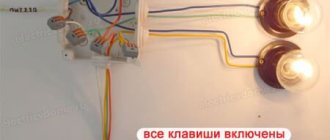What to do if you want to install new light switches in your apartment, the renovation of which was completed a long time ago.
At the same time, I absolutely don’t want to re-drill the walls, remove suspended ceilings, install new wiring, socket boxes, etc. Is there a way out in this situation? There is, and it’s absolutely inexpensive. All costs can cost you between 500-1000 rubles. At the same time, you won’t spend a penny on new wires and won’t cut through a single extra centimeter of the walls.
Types of switches
- Spinning. These switches are round scrolling buttons. The light turns on and off after a characteristic click. They also allow you not only to turn the light on and off, but also to simply reduce the lighting level.
- In the form of keys. They are the most popular, allowing you to switch different light sources using a different number of buttons.
- There are also switches with a motion sensor. They turn the light on and off automatically as a person moves around the room.
- Remote. Such switches are a system with a remote control.
And a huge number of different types of switches. The most convenient are remote switches. They can be switched from anywhere in the room, they do not require a wired connection and operate on batteries. An additional block is installed in place of the old switch.
Using sensors to control lighting
Various motion sensors for remote control of lighting are widely represented on the lighting market. The most common of them are infrared. They are devices that close or open the lighting circuit when the level of infrared radiation increases in their “visibility” zone. As soon as a person or animal whose body temperature is higher than the background temperature enters the sensor’s field of action, the light turns on. As soon as a person leaves the sensor’s coverage area or remains in a stationary position for several seconds, the light turns off. Motion sensors are most often installed in entrances, above the front door, and less often - inside the apartment.
What is a wireless switch
A Wi-Fi light switch is a device that is connected to the lighting source circuit. It consists of:
- transmitter (remote control or switch);
- relay for receiving a signal (actuator). It is installed directly in front of the electrical appliance.
What does a wireless switch look like?
Using the device solves two main problems:
- eliminating the installation of additional electrical wiring;
- the ability to control lighting devices from a distance.
For your information! The actuator opens and closes the electrical circuit. This occurs when a corresponding signal is received from the transmitter. It is supplied by the wireless light switch itself by converting an energy pulse into a radio signal. The actuator reads this signal.
Despite the apparent simplicity of the device, it is quite high-tech. A wireless walk-through switch provides comfort when using electrical appliances in living areas.
Advantages and disadvantages
Remote lighting control devices have both advantages and disadvantages.
The advantages of this type of device include the following characteristics:
- Easy to install. Installation and connection do not involve cutting walls or laying electrical wiring.
- The ability to control all lighting fixtures from a single remote control (smartphone, computer).
- Wide signal reception area. In open areas, the signal extends to 20–350 meters. Walls and furniture slightly reduce the signal range.
- Safety for residents. The remote switch is designed for a low operating current, and therefore even if the structure is carelessly damaged, a person will not cause harm to his health.
Disadvantages of wireless systems:
- In terms of price, wireless devices are less accessible compared to traditional ones.
- If the battery in the remote control runs out, you will no longer be able to control the system. The same problem occurs with a poor Wi-Fi connection.
Specifications
As an example, let’s look at the characteristics of a standard device for turning the light on and off by clapping.
Device data:
- Power is supplied from a standard network with a voltage of 220 Volts.
- The maximum total power of consumers does not exceed 300 Watts.
- Sound control ranges from 30 to 150 decibels.
- Permissible temperature range: from 20 degrees below zero to 40 degrees above zero.
- Housing protection class - IP30.
A variety of lamps are used in the network:
- Incandescent and halogen light sources.
- Energy-saving or fluorescent light bulbs.
- LED devices.
The specified characteristics comply with the requirements of the law of the Russian Federation number 261. This act regulates the rules for the rational use of electrical energy.
Programming
After installation, the device begins to work like a regular touch switch. To switch lighting lines over a radio channel, the device must be programmed.
Each group (key) is programmed separately, as a separate device.
So, touch the desired sensor and hold it until short beeps appear. Sound signals indicate the moment of programming we need. When held for a long time, the sounds occur in the following order: 1 short – pause – 2 short – pause – 3 short – pause – 4 short.
The pauses between series of “peaks” are very short; during this pause you need to press the desired key on the transmitter (key fob or switch) and the receiver will be programmed for this signal. After the 1st short sound, the selected signal of the transmitter is switched on and off. After 2 short pulses, a signal is set to turn on
.
After 3 beeps, a command is given to turn off
. When the switch beeps 4 times, all settings are reset and you need to rebind the transmitters.
Based on experimental data, it became known that for stable operation there is no need to assign more than 4 signals from different devices to one group.
Well, in conclusion, the promised links to Aliexpress: Switch-receiver with key fob Switch-receiver with wireless switch
Rate this publication:
- Currently 4.18
Rating: 4.2 (11 votes)
The best manufacturers
At the moment, there are not many companies that produce Wi-Fi circuit breakers. However, there is still competition, and they have to maintain their position in the market and be responsible for quality.
Here are some of them:
- French company Legrand. It has been on the market for a long time, has proven itself well, and produces a large line of products under the Celian brand.
- Vitrum (Italy). They were the first to introduce Z-Wave technology into their circuit breakers, which made it possible to completely mechanize lighting control.
- Delumo. A Russian company that, in addition to wireless switches, produces dimmers and thermostats.
- Kopou (China). In addition to switches, it also produces various types of dimmers, including in the form of key fobs and other designer items.
- Livolo (China). In addition to wireless switches, the company produces all kinds of devices and other types of automation systems to simplify home and industrial life. Produces frames for switches.
- Xiaomi. Offers its own Aqara line. These are usually key switches with software and physical control.
The Belarusian company Noolite is also popular among many consumers on the Russian market and has not yet lost its position.
How to connect?
The cotton switch “Ekosvet-X-300-L” in question consists of a block in which the entire circuit is mounted, and two pairs of wires - white and black. The white ones need to be connected to a 220 V electrical network, the black wires are connected to the lighting load.
The lamp receives zero (directly) and phase (through an ordinary household switch) from the distribution box. These two wires are connected to the white wires. You can do this using the old-fashioned twisting method, but it is better to use special self-clamping terminals.
The black wires are connected to the lamp socket itself. That is, with the usual circuit, phase and zero from the supply network would go directly to the lamp socket, and so you also additionally inserted a cotton (or acoustic) light switch into this circuit.
The block itself must be secured to the body of the lighting fixture. The unit has a sensitivity regulator, with which you can set the desired level of cotton. It is most advisable to set the so-called medium level, so that it is not too light, otherwise the switch will start to operate at the slightest tap, and not too strong, so as not to knock off your palms.
The clapper switch is powered through a regular keypad mounted on the wall. If you need to remove a fancy sound device from the circuit, it will be enough to turn off the key switch.
All that remains is to experimentally test the results of your work. When operating correctly, Ecosvet-X-300-L will only respond to clapping of palms. Tap with a hammer, bring a running vacuum cleaner close to the lamp, beat it in a mug with a spoon, turn on a hammer drill, tease with a mobile phone signal. We don’t know what your experiments will show, but there have been cases when cotton switches were triggered by the sound of a working hammer drill or the ringing sound of a metal spoon hitting a mug. This is further confirmation that there are few ideal things in the world; any device, especially in electrical engineering, has, along with advantages, a number of disadvantages (even if completely insignificant).
Connection errors
The main problem during installation is always not taking into account the power of consumers. For most touch-sensitive light switches, the maximum throughput load is limited to 1 kW. In no case should it be exceeded. Most devices of this type do not contain safety elements that block excessive load. Hence their relative fire hazard when the maximum is exceeded.
Another relatively common mistake when installing 220V touch-sensitive light or energy switches is the incorrect connection of the contact groups. For example, it has been noticed more than once that they try to separate the zero of the power supply network with a control device, instead of a phase. Of course, this creates significant problems in its functioning; it becomes simply impossible.
The practical connection of a phase and a COM port for end devices does not make much sense. However, its purpose is different - to communicate with other switches or pass-through switches.
Connecting the built-in transmitter
Designed to expand the capabilities of existing lighting, a universal radio transmitter is mounted in a deep socket behind a standard switch and connected to its contacts. When AC voltage is applied to the control inputs, the module sends a command via radio channel to the actuator. To achieve maximum operating range, the antenna wire is placed straight and brought out closer to the outer surface.
Wiring diagram of a two-channel built-in remote control: 1 – universal radio transmitter; 2 – socket box; 3 – gypsum solution; 4 – standard switch; 5 – antenna wire; 6 – keypad.
Distinctive features of wireless devices
Modern wireless switches, manufactured under different brands, are similar in design and operating principle. The devices differ in the following parameters:
- type of control (push-button, touch, remote);
- the ability to control the intensity of the light flux in the room (whether present or not);
- number of devices to be managed (from 1 to 8 depending on the model and manufacturer).
In addition to the above items, there are significant differences in functionality. The majority of devices simply control the switching on/off of lights in rooms, and only advanced models are equipped with additional features such as:
- response delay - the device is activated or deactivated not immediately at the moment the button is pressed, but somewhat later, for example, while a person is walking towards the bed or to the exit from the room;
- multi-channel control - it is possible to configure several channels, allowing you to turn on several devices at once, even those located in different rooms of the same building;
- touch panel - there are no buttons that can lose sensitivity over time and fail. To activate the equipment, just touch the display;
- availability of Wi-Fi - the extension makes it possible to send a signal through available gadgets such as a smartphone, tablet or computer with Internet access.
The wider the functionality of the device, the higher its cost.
Wireless type switches look attractive, fit easily into the interior and give the decorative design of the room elegance and a stylish, modern look
The premium class includes “smart” wireless switches with a wide coverage radius (up to 350 meters), equipped with an internal energy generator, a touch control panel and the ability to multi-control the lighting system.
Such devices are usually installed in large houses, large apartments or country cottages that have an extensive lighting system.
Budget ones include simple battery-powered modules. Their coverage area is limited to 20-50 meters, which is quite enough for an average city apartment.
Remote control system for light in an apartment
Light control scheme via the Internet
Light control in an apartment can be carried out by switches with a range of up to 100 m or less, depending on the area of the room. If there are load-bearing walls or iron reinforcement in the walls along the signal path, there are radio signal repeaters that allow you to bypass obstacles and increase the power of the transmitting device.
You can install 2 light control systems in your apartment:
- Local, if one lighting source is connected to one switch.
- Global. In this case, all lamps and spot groups will be connected to a single control panel. The scheme may include air conditioners, ventilation systems and other electrical devices, for example, automatic blinds or roller shutters.
In large apartments it is possible to combine the operation of sensors and a remote switch. This is necessary for temporary lighting of passage areas. The sensor is installed in the direction of travel and is triggered if a person enters a certain area, then turns off.
The device can operate in several modes:
- Temporary. When you press the button, the light turns on for a certain time, then goes out on its own.
- On/Off. When the button is pressed once, the devices are either turned on or off.
- In monostable mode, holding down the button will keep the light on. If you let go, it will go out.
- Bistable mode is a cyclic change in the operating state of the device.
The more modes, the more expensive the equipment.
How to choose a remote switch
When selecting a remote light switch, you need to pay attention to many different factors and parameters. Of course, first of all, do not forget that the interior design should be supported even in such small things as the light switch.
If you want to decide on the design of the switch in advance, before purchasing, evaluate the models by viewing photos of remote switches on the Internet.
The kit should always include instructions that will tell you how to connect the remote switch.
It is imperative that the price matches the quality of the model. To do this, it is better to choose well-known manufacturers of electrical equipment. If you are not well versed in this matter, be sure to consult at the point of sale.
And don’t skimp on quality; cheap models are unlikely to last you a long time, which is why it’s better to choose more expensive models. You can connect any of these switches with your own hands, since the current voltage is not high.
Just recently, remote switches were a novelty on the market, but now they are a modern and popular device that makes people's lives easier and more comfortable. If you have already decided to purchase such a switch, this article will tell you how to choose a remote switch.
Characteristics you should pay attention to when choosing
When purchasing a wireless remote switch, you should pay attention to the following parameters:
- The type of light bulbs the device controls;
- Material, color and appearance of the case;
- Operating voltage;
- Number of channels;
- Radius of action;
- Maximum load;
- Dimensions;
- Rated current;
- Equipment.
It is also worth paying attention to the following criteria:
- Operating frequency range;
- Signal transmission method;
- Availability of encoding;
- Transmitter power type;
- Estimated battery replacement time;
- Fastening method;
- Operating temperature range;
- Price.
Types and types of switches
Switches are divided by type, type, each type has its own methods of application. And just in the table below, we see their division by degree of protection.
Currently, the international protection system (IP) is widely used. These letters are followed by two numbers and an optional letter.
Switch protection levelsThe first number indicates that the product is protected from foreign objects entering it. These objects have any size, up to the size of dust particles. The second number usually indicates the degree of protection from moisture. It has a correlation dependence: the larger the numbers, the higher the degree. Switches differ in the method of switching - they can be with screw or screwless terminals. In the case of screw terminals, the wires are clamped between the plates using a screw. However, there is one drawback to this connection - over time, there is a high probability of the contact weakening, so you have to periodically tighten the screws. The screwless clamp makes installation work much easier and, due to the design of the mechanism, reliable contact of the wire with the conductive fittings is ensured.
Key switches
The switches consist of contacts fixed inside the housing and a swinging mechanism pressed by a spring. Keyboard switches can be divided into two variations:
Switch types
- Using a ball that, when you press a key, begins to move along a swinging rocker arm. As it passes the axis, it rolls along the shoulder of the rocker arm, thereby moving the mechanism with contacts in the other opposite direction.
- Type of switch using a spring-loaded frame. Since it has the ability to swing on its axis, it thereby breaks or creates electrical contact.
Regardless of the type of device, turning the equipment on and off is done by pressing a key. Such switches, when used correctly, are characterized by a long service life of several decades. And their cost is low. You can find different types of designs on the market: there are lighter ones, and there are more complex ones - when two or more keys are attached to one base.
Corded switches
This option from the era of the last century is ideal for sconces, table lamps and other lamps. Because their main feature is the presence of a durable cord that comes out of the switch body. Actually turning this item on and off occurs precisely due to this cord. Fixed on the lever, it, in turn, interacts with the moving contact block. By releasing the lace, you straighten the spring fixed in the housing and the block returns to its original place. The unusualness of this type is manifested in the modification - control of two or more light bulbs. They respond to the amount of tension on the lace.
At the first pull, one of the lighting units turns on, at the second, the next one, and so on. Switching off occurs in the reverse order.
Design and connection of the switch in the LED profile
The touch communicator consists of the following elements:
- shell (for built-in views, its role is played by a diffusing screen);
- sensitive element - spring, infrared sensor and receiver, motion sensor;
- switching circuit - signal to electrical converter.
LED strips and their breakers are designed for a voltage of 12–24 V, so they are connected to the network only through a power supply.
If the sensor is installed in a ready-made luminaire, the plug and diffuser are first removed. According to special markings, the tape is cut into 1–2 sections to make room for the switch.
You will need special connectors or low power soldering irons (25, 40 W) to connect the wires. Standard cable cross-section is 1.5 mm2. For illumination longer than 5 m, the calculation is performed individually.
First, the stripped and crimped wire strands connect the switch to the connector in front of the power supply, and then to the illuminator.
The markings will tell you how to easily connect the selected touch switch to the LED strip:
- VCC, GND - plus and minus that come from the power supply;
- LED+, LED- - go to diodes.
The adhesions are insulated with hot glue or heat shrink tubing. In the selected device, the working parts should occupy one side. If they are on different sides, the switch cannot be fixed in the profile. The location of the sensor is indicated by a blue LED. The tape together with the switch is fixed in an aluminum profile with double-sided tape, a protective panel is installed and secured with a plug.
Manufacturers
The most famous models presented on the Russian market are “Ecosvet” and “Claps”. Let's look at their main characteristics.
Switch "Сlaps"
One of the newest developments is the “Claps” cotton switch model. In this device, the sound is processed using a microprocessor; it does not react to any extraneous noise, but is tuned to several claps in a row (this is the most important operating condition).
It is permissible to install several such switches in one room, each of them will react to a certain number of claps, and accordingly turn on the light, humidifier, fan, TV or stereo system. This switch model is suitable for any household appliances that have an electrical cord.
Perhaps to some, the clap switch may seem like a toy or a completely unnecessary device. Others, on the contrary, are passionate about the idea of creating their own “smart home” so that lights and electrical appliances turn on and start working on command or clap. Arrange your life the way you want, but at the same time make it as comfortable as possible.
Ecolight switch
The Ecosvet device is designed to work with 220 Volt light bulbs.
Main parameters of the device:
- load - 300 Watt;
- sound signal spread - from 30 to 150 decibels;
- housing protection level - IP30;
- permissible temperature range - from 20 degrees below zero to 40 degrees above zero;
- cost - from 350 rubles.
“Ekosvet” is fixed with self-tapping screws using the mounting legs. It is not recommended to install the device in noisy rooms. Despite the fact that “Ekosvet” is configured to clap, false alarms are possible.
The figure above shows the device connection diagram. "Ecolight" is connected to a conventional switch to provide the ability to de-energize the circuit and stop its operation.
Controlling lighting from your phone
At first, touch control of light was used only in conjunction with the construction of a smart home, however, nowadays you can find a special photo relay in any room. Automatic lighting can make a person's life easier. A multi-channel switchboard is capable of turning on the lighting of all rooms from one point.
Experts highlight the following advantages of a remote lighting control system:
- Control using radio waves can increase the security of the apartment. You can control the light from your phone, personal computer or using a timer. This will protect the apartment from intruders in the absence of the owners.
- Great savings in necessary materials. To run cables to the switches you need a lot of expensive wire. It will also need to be replaced over time. The electronic control system needs a small amount of wire.
- There is no dependence on the electrical power supply network. The multi-channel cabinet and circuit breakers are connected using radio waves, and all light control is carried out without connecting to a local network.
Such a control system is most convenient when it is necessary to control the lighting level in many places at the same time. It can be combined with a dimmer, which will provide the most comfortable lighting in the room.
Types of proximity switches
The operating principles of the sensing element in non-contact models may differ depending on the operating conditions and the required speed. In this case, the device design always includes the following components:
- sensing element;
- element for signal processing;
- power key.
The following types of sensors are used: capacitive, inductive, optical, ultrasonic. The features of these devices will be discussed below.
Capacitive sensors
The operation of capacitive sensors is based on interaction with the human body: when a person is nearby, electrical capacitance is created, resulting in the activation of a time-setting multivibrator circuit. The closer a person is to the switch, the larger the volume of the capacitance and the lower the frequency created by the multivibrator. After the frequency overcomes the minimum threshold, the device turns on, but as soon as a person moves a certain distance, the sensor switches off.
The function of the sensitive element in the device is performed by a plate superimposed on a capacitor, which, in turn, is connected to a multivibrator. At the output, the multivibrator is connected to a frequency and voltage converter, as well as a comparator, which acts as a threshold element.
Inductive sensors
Contactless switches of this type respond not to the presence of a person, but to the movement of a magnet. Depending on the design of the magnetic product, the sensor is made with a metal or magnetized core. An inductive sensor creates electrical impulses of different directions depending on the approach or distance of an object. The signal is processed by a threshold element: after exceeding a certain voltage level on the sensor winding, a trigger is turned on, which opens the key.
Optical sensors
Optical devices include infrared LED and phototransistors. The LED operates regardless of interference caused by natural light. The device can reflect light (how a barcode reader works) or interrupt the flow (an object must be placed between the sensor and the light source).
Ultrasonic sensors
Ultrasonic devices use quartz sound emitters. A receiver tuned to a specific frequency responds to sound. Ultrasonic devices have another name - motion and volume sensors. Moreover, in a room where there are no moving objects, the return period and signal amplitude are constant. If a moving object appears in the room, the sound waves are distributed differently, which is reflected in a change in the signal received by the sensor.
Components of the wireless module
The design of a wireless switch is very simple and consists of two working components: a receiver and a transmitter. Each of these nodes has its own area of responsibility and performs strictly defined functions that ensure correct control of the lighting system.
Design and principle of operation of the receiver
The receiver is a radio-controlled relay, which during operation picks up the corresponding signal and closes the galvanic circuit of household electrical wiring.
The relay is placed as close as possible to the lighting fixture, or somewhere in the neighborhood, but always in a place that falls within the coverage area of the transmitter.
Due to the compactness of the receiving radio relay, it can be placed in a chandelier, sconce or floor lamp. When you want to take control of the control of spotlights, it is appropriate to “hide” the receiver behind the suspended ceiling
Another option is to mount the element into a distribution box, if its dimensions allow this to be done technically. The mini-device is controlled from a remote control, smartphone, tablet, computer via Wi-Fi or radio waves.
Specifics of the transmitter operation
For correct operation, the transmitter does not need to be connected to an active power supply. Power is provided by autonomous energy sources - batteries.
More advanced models have a small internal generator that generates electric current when the user presses a key. The energy pulse that occurs at this time is transformed into a radio signal, which is picked up by the receiving device.
Commands to the module are given from the remote control or via a phone with access to Wi-Fi. In this way it is possible to control up to 8 devices simultaneously
A signal transmitter equipped with an energy generator is more expensive than a similar battery-powered model. But the price is quickly compensated by the ease of use, and the owners do not have to think every time about how not to forget and replace worn-out batteries in a timely manner.
The coverage area of a device depends on many parameters. This is primarily influenced by the general technical characteristics of the product and the structural features of the room (layout, presence of furniture, false walls, etc.) where the module is located.
Simple budget devices transmit the correct signal within a radius of 20-50 meters. In more advanced models, this figure reaches 350 meters, but the price for such powerful devices is still high.
The signal transmitter, operating on rechargeable batteries, does an excellent job of turning on and off the lights in rooms, serves for a long time and requires only one thing from the owners - timely recharging of the batteries using a charger
Some manufacturers produce products with expanded functionality. “Smart” devices take on not only the standard control of turning on/off light bulbs, but also regulate the intensity of lighting devices and the degree of illumination of the room. This mode is ensured by a special component – a dimmer.
The device, equipped with a dimmer, allows you to set the most convenient level of luminous flux saturation. This action is carried out by holding or scrolling the operating button located on the switch itself
The purpose of the dimmer is to regulate the electrical power responsible for the brightness of the light. The device works normally with both LED and traditional incandescent lamps.
Wireless light switches
It’s no surprise that today there are wireless light switches. Their main advantage is that you don’t have to hammer the walls every time you turn on the light, therefore, you won’t have greasy circles on the wallpaper.
It can also be installed in absolutely any place in your house or apartment, practically without spoiling the wall design. It covers large areas and is capable of monitoring the entire house.
The device itself is small in size; it can be placed in the lighting fixture itself. There are quite a few wireless switches; they are divided into only three characteristics: how many lamps they can control, the control method and the ability to adjust the lighting fixtures. Its main feature is easy installation, which does not require a professional.
Application
It is advisable to purchase and then install wireless switches (instead of traditional devices), if necessary:
- Turning lights on or off at great distances. Installation of wiring is expensive, the radio switch (depending on the product) operates within a range of no more than 350 meters.
- Transferring any device. In order not to move bulky furniture and to avoid damaging the finish, the device can be installed on the wall, inside the cabinet.
- Elimination of installation defects. When moving the power line, there is no need to trench the walls; it will be enough to connect the mechanism with or without a remote control.
- Ensuring convenient use of electrical appliances. The contactless switch does not take up much space and is easy to operate.
- Control lighting throughout the house. A small functional device with a remote control provides the ability to control connected light sources from several zones.
- Saving the design idea. If the switch cannot be installed inside a niche, the wireless device will fit perfectly into any interior style.
Important! In wooden buildings, when flammable building materials are used inside the buildings, the laid cable significantly increases the likelihood of a fire. The use of distance structures will be the most economical and simple solution.
Modern wireless switches have a stylish appearance and can be installed within a few minutes Source elektrikexpert.ru
What does the market offer?
A wide range of wireless remote switches allows you to choose a product based on price, characteristics and appearance.
Below we consider just a few models that the market offers:
- Fenon TM-75 is a remote-controlled switch made of plastic and designed for a voltage of 220 V. The features of the device include the presence of two channels, a 30-meter range, the presence of a remote control and a delay switch function. A group of lighting fixtures can be connected to each channel and controlled. The Fenon TM-75 wireless switch can be used with chandeliers, spotlights, LED and track lights, as well as other devices operating on 220 Volts.
- Inted 220V is a wireless radio switch designed for wall mounting. It has one key and is installed in conjunction with the receiving unit. The operating voltage of the product is 220 Volts, and the range is 10-50 meters. The wireless light switch is attached using self-tapping screws or double-sided tape. The body is made of plastic.
- INTED-1-CH is a light switch with remote control. With this model you can control light sources remotely. The power of the lamps can be up to 900 W, and the operating voltage of the product is 220 V. Using a radio switch, you can control the equipment, turn on and off the lights or alarms. The product is based on a receiver and transmitter. The latter has the form of a key fob, which is small in size and transmits a signal over a distance of up to 100 m. The product body is not protected from moisture, so additional protection must be provided when installing outdoors.
- Wireless touch switch controlled via remote control. The product is mounted on the wall, has small dimensions and is made of tempered glass and PVC. The operating voltage is from 110 to 220V, and the rated power is up to 300 W. The package includes a switch, remote control and bolts for attaching the accessory. The average life cycle is 1000 clicks.
- Inted 220V 2 Receiver - Wireless Light Switch for Wall Mounting. Control is carried out using two keys. The body is made of plastic. The operating voltage is 220 V. The number of independent channels is 2.
- BAS-IP SH-74 is a wireless radio switch with two independent channels. Control is carried out using a mobile phone on the Android operating system. To work, you must install the BAS application. The SH-74 model is used to control incandescent lamps with a power of up to 500 W, as well as fluorescent light bulbs (power limit - 200 W).
- Feron TM72 is a wireless switch that controls lighting at a distance of up to 30 meters. The light sources are combined into a receiving unit, and switching on and off is done using the remote control. The TM72 model has two channels, each of which can be connected to a specific group of devices. The product has a large power reserve per channel (up to 1 kW), which allows you to connect different types of light sources. The big advantage of the model is the presence of a delay ranging from 10 to 60 seconds.
- Wireless 3-channel switch 220V Smartbuy is designed for connecting light sources into three channels with a power limit of up to 280 W. The rated supply voltage is 220 V. Control is carried out from the remote control, which has a range of 30 meters.
- Z-Wave CH-408 is a wall-type radio switch that allows you to program various scenarios for controlling lighting devices. If necessary, up to eight switches can be connected to it. Among the additional features, it is worth highlighting the management of Z-Wave devices (up to 80) and ease of configuration regardless of the main controller. The device is powered by two batteries, and when they are low, a corresponding signal is given. Firmware updates are performed via the Z-Wave network. The maximum distance to the controller should not exceed 75 meters. Protection class - IP-30.
- Feron TM-76 is a wireless light switch that is controlled remotely using a radio signal. The receiver connects to light sources, and the remote control controls the receiving unit at a distance of up to 30 meters. The Feron TM-76 model has three independent channels, each of which can be connected to its own group of lighting fixtures. In this case, control will be carried out separately, using the remote control. The maximum power reserve is up to 1 kW, which allows you to connect various types of lamps (including incandescent). The operating voltage is 220 V.
Operating principle and design
Receiver and Remote Switch
Structurally, the remote lighting switching device consists of a receiver and a signal transmitter.
More details about these devices:
- Receiver. The element is made in the form of a radio relay controlled via a remote control. You can turn the light off and on from a mobile device connected to a Wi-Fi network, as well as from a wired switch. As a result of receiving a signal, the relay is activated and closes the contact elements or opens them. It is advisable to install the device in close proximity to the lighting fixture or inside it, if dimensions allow. In the case of spotlights, the device must be installed in the distribution panel or in the free space between the suspended and main ceilings.
- Transmitter or remote control. The device structurally consists of a generator that generates electricity after activating a button on the remote control. Generation occurs after touching the sensor or transmitting signals from a mobile gadget. Electrically, the signal is converted into a radio pulse, which is picked up by the receiver. The transmitter can be installed in the wall or not installed at all, but carried with you. There is a power source inside the remote control, so there is no need to connect it to an electrical line.
Infrared control
Lighting devices are controlled by exposure to infrared radiation. To do this, the processor control module must be connected to the lighting circuit break. The action can be performed using the TV remote control. The device is pointed at the processor module, after which a button is pressed, which does not switch television channels. This leads to commands being written to the device’s memory, and then the lighting is controlled from the pressed key. The main disadvantage of this control method is the need to ensure line of sight at a short distance.
Radio wave control
This control option is more common. Signals are transmitted to the radio switch from the remote control to the processor module. which is tuned to operate in a specific frequency range. Packet data is exchanged using special codes. High reliability of signal transmission from the remote control to the radio switch itself is ensured by creating the required level of pulses and repeating them in a certain sequence. The signals are repeated several times. To prevent a situation where the lighting is triggered by a neighbor's remote control, each switch is assigned its own unique address.
Radio-controlled devices often use non-volatile controllers, which allows them to be used without connecting to a household network.
There is a button on the switch that can be used to turn off the remote control and switch the lighting manually. Such devices may be equipped with a search key, by clicking on which you can find a lost remote control. The device will report its location using sound signals. Lighting control is possible using a mobile device or computer. To do this, you must first download the program to the device and configure specific commands.
Radio-controlled switches are divided among themselves according to the power used, which can reach several kilowatts. It is possible to configure devices to work with individual lighting fixtures or entire lighting systems. The best option would be to control different groups of lamps from a common transmitter.
Mr. Borisych spoke about the principle of operation of wireless radio switches.
Types of switches
Wireless remote switch with remote control
There is a wide range of household switches on sale, controlled by remote control and telephone, designed for power consumption in the range of 0.5-3.5 kW.
- Delayed. Once turned on, the lamps remain lit until they are forced off. Another option is products that glow for 10-60 seconds after activation. These are usually installed in corridors and other passage places.
- With channel settings. These are the most complex and expensive devices, designed to operate in different modes. The products glow in one range or automatically switch the signal in accordance with the settings.
- Wireless. The best option for those who prefer to control lighting without leaving the couch. This option is convenient because in the dark you can turn on the lamps in the necessary rooms without moving from switch to switch in the dark.
- Sensory. Products are produced with displays through which they are configured and programmed.
Overview of remote switches
Among the most well-known models on the market, we especially highlight the IR remote light switch of the Sapphire-2503 type, produced in Belarus, as well as a system with a radio-controlled channel of the Nootekhnika Noolight brand. The product of the first of these companies can be seen in the photo below.
Remote control type "Sapphire-2503"
Another type of wireless switches and switching devices for lighting equipment over a radio channel is produced by the well-known. These include such common models as AWST-8800, AWST-8801, as well as the portable key fob “CoCo” AKCT-510 and the built-in transmitter AWMT-230.
Models from the last two manufacturers of remote control systems are more practical and convenient than similar switches with signal transmission via an IR channel. With their help, it is possible to simultaneously control all lighting equipment in the house from almost any point (from the most remote rooms). The presence of special dimmers in the set of these devices significantly expands the capabilities of the system and allows you to adjust the illumination of internal spaces.
The portable control panels included in their composition allow the possibility of choosing one or another scenario of actions leading to the connection of light. More “advanced” products from the considered manufacturers may contain a special RGB controller capable of performing a number of operations, namely:
- Turn on lighting at a given address or in the entire house at once;
- Adjust the brightness level of the lamps;
- In accordance with the given program, set the desired ratio of different color gamuts with LED backlighting and sort through them sequentially.
Due to the fairly compact size of the electronic part of these devices, the remote switch can be placed inside the glass of a chandelier or lamp. When controlled from a remote control, it can be switched over a radio channel from a distance of about 30 meters.
Most of the considered control system samples are capable of working with household consumers designed for power up to 3.5 kW. To connect them yourself, you must perform the following mandatory operations:
- First, a load with a suitable operating power for the device is selected;
- After this, the voltage from the house or apartment is removed automatically by the introductory machine;
- At the final stage of the work, a power unit responsible for turning off the light is installed into the break in the supply line.
All details of connecting the final execution device can be found in the next section.


